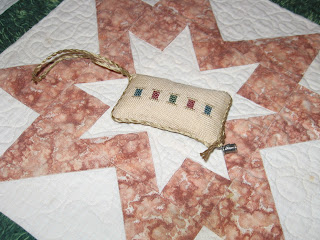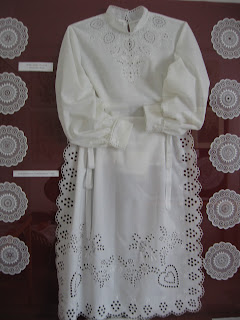Csipke is the Hungarian word for "lace". I refer to the pieces that I have as "embroidery" but in Hungary they call it "lace". I think it is a little bit of both. Buttonhole stitches are used to create the holes, satin stitches are used to embellish and the holes are filled with needlelace - this combination of techniques create beautiful works of art!
My interest wa
s in Hövej embroidery or lace, but there are many other types of lace made in Hungary. You are probably familiar with Kalocsa Lace. Kalosca lace includes brightly colored flowers which are embroidered by hand. The surrounding area is then cut out and machine embroidered to create a lacy effect. Another popular lace in Hungary is called Halas Lace. Halas lace was developed in the small village of Kiskunhalas, located about a hundred miles south of Budapest. This lace is worked with a needle and thread over a paper pattern. From what I have read, this type of lace is quite rare as there are not very many lacemakers making it today. Here's a link to an interesting article on the internet if you would like to read about these two types of Hungarian Lace: Lacemaking in Hungary.
And so we return to Hövej. I want to share with you some additional photos of this beautiful embroidery; this time from the Csipke Museum in Hövej.
The pieces in this museum have been collected by the village and have been made by a variety of different women.
Sorry for the reflections in the glass! Of particular interest to me were some of the framed patterns that were displayed. I'm certain that they were quite old!
Proof that there must have been a pattern book of some kind at one time!
More beautiful Hövej embroidery:
And the ladies that made it popular:
When I sit down at the end of the day to stitch, it's usually so that I can steal a few minutes of quiet time, to relax and unwind after a busy day. The pieces that I make are for my own enjoyment, or I give them as gifts to friends and family. I'm rarely under a time constraint and often work on certain pieces for months on end.
These women rarely stitched for themselves. They generally had orders to fill for the Handicraft Cooperative which then sold the pieces to the wealthy people in Kapuvar; many of the pieces were sold to the Swiss, and some pieces made their way to the U.S. The women relied on the income from their embroidery to help support their families.
I'm glad that the village of Hövej has taken steps to preserve this part of their history. It was encouraging to see that there are women in the village today who want to learn how to do it so that the tradition of making Hövej lace will continue.























































